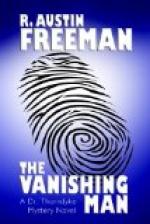“Suspicion, however, is one thing and proof is another. I had not nearly enough evidence to justify me in laying an information, and I could not approach the Museum officials without making a definite accusation. The great difficulty of the case was that I could discover no motive. I could not see any way in which Mr. Jellicoe would benefit by the disappearance. His own legacy was secure, whenever and however the testator died. The murder and concealment apparently benefited Hurst alone; and, in the absence of any plausible motive, the facts required to be much more conclusive than they were.”
“Did you form absolutely no opinion as to motive?” asked Mr. Jellicoe.
He put the question in a quiet, passionless tone, as if he were discussing some cause celebre in which he had nothing more than a professional interest. Indeed, the calm, impersonal interest that he displayed in Thorndyke’s analysis, his unmoved attention, punctuated by little nods of approval at each telling point in the argument, were the most surprising features of this astounding interview.
“I did form an opinion,” replied Thorndyke, “but it was merely speculative, and I was never able to confirm it. I discovered that about ten years ago Mr. Hurst had been in difficulties and that he had suddenly raised a considerable sum of money, no one knew how or on what security. I observed that this event coincided in time with the execution of the will, and I surmised that there might be some connection between them. But that was only a surmise; and, as the proverb has it, ‘He discovers who proves.’ I could prove nothing, so that I never discovered Mr. Jellicoe’s motive, and I don’t know it now.”
“Don’t you, really?” said Mr. Jellicoe, in something approaching a tone of animation. He laid down the end of his cigarette, and, as he selected another from the silver case, he continued: “I think that is the most interesting feature of your really remarkable analysis. It does you great credit. The absence of motive would have appeared to most persons a fatal objection to the theory of, what I may call, the prosecution. Permit me to congratulate you on the consistency and tenacity with which you have pursued the actual, visible facts.”
He bowed stiffly to Thorndyke (who returned his bow with equal stiffness), lighted the fresh cigarette, and once more leaned back in his chair with the calm, attentive manner of a man who is listening to a lecture or a musical performance.
“The evidence, then, being insufficient to act upon,” Thorndyke resumed, “there was nothing for it but to wait for some new facts. Now, the study of a large series of carefully conducted murders brings into view an almost invariable phenomenon. The cautious murderer, in his anxiety to make himself secure, does too much; and it is this excess of precaution that leads to detection. It happens constantly; indeed, I may say that it always happens—in those murders that are detected; of those that are not we say nothing—and I had strong hopes that it would happen in this case. And it did.




